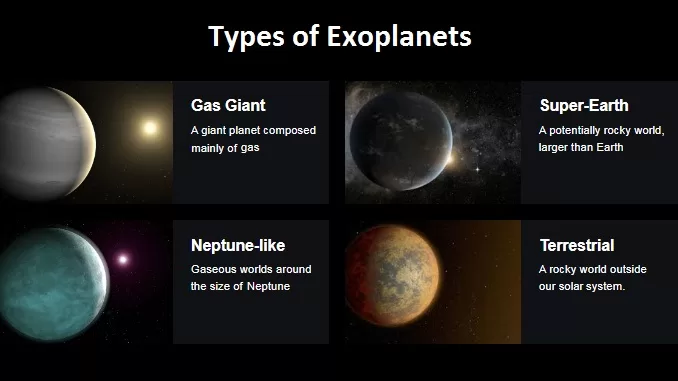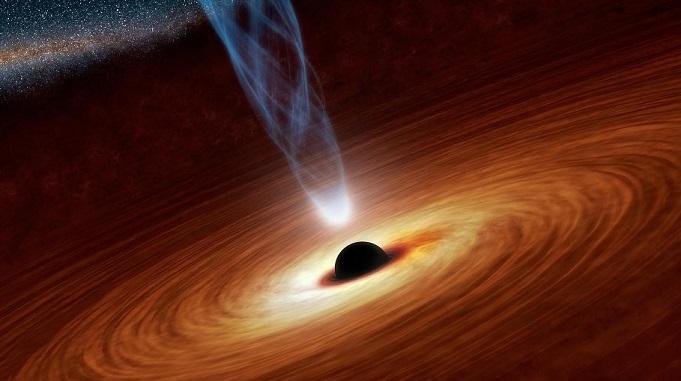
What is an Exoplanet?
Definition of an Exoplanet – Any planet beyond our solar system is an exoplanet or an Extrasolar planet.
In our solar system, every planet revolves around the Sun. Exoplanets, or Extrasolar planets, are planets that orbit around other stars. Most exoplanets orbit other stars, but free-floating exoplanets called rogue planets are unattached to any star and orbit the galactic center.
Exoplanets are extremely difficult to directly see using telescopes. The bright light from the stars they orbit obscures them. So, astronomers employ various techniques to find and study these far-off planets. They look for exoplanets by observing the effects these planets have on the stars they orbit.
Types of Exoplanets
The planets outside of our solar system are called “exoplanets.” Exoplanets come in a wide variety of sizes, from massive gas giants larger than Jupiter to small, rocky planets that are roughly the size of Earth or Mars.
They may be hot enough to boil metal, or locked in deep freeze. They can orbit their stars so rapidly that a “year” only lasts a few days, and they can simultaneously orbit two suns. Some exoplanets are sunless rogues that rove through the galaxy in permanent darkness.
Read Also – Connections between Galaxies Near and Far revealed by NASA’s Webb Telescope
So far astronomers have categorized exoplanets into the following types:
1. Gas giant Exoplanets,
2. Neptunian Exoplanets,
3. Super-Earth Exoplanets, and
4. Terrestrial Exoplanets.
A Galaxy of Stars – and Planets
The Milky Way, our galaxy, is a thick and broad stream of stars that cuts across the sky on the clearest, darkest nights. At least 100 billion stars, including our Sun, are found in its spiraling expanse. And if each of those stars has a whole system of planets instead of just one planet, as our Sun does, then the number of planets in the galaxy is truly astronomical: it is already heading into the trillions.
For thousands of years, humans have speculated about such possibilities, but our generation is the first to know, with certainty, that exoplanets really exist. In fact, way out there.
Closest Exoplanet like Earth
Proxima Centauri b is our closest known exoplanet neighbor, located only 4 light-years away, or more than 25 trillion miles (40 trillion km). Proxima Centauri, our nearest known neighboring star, was found to have at least one planet, probably a rocky one.
Proxima b is a super Earth exoplanet that orbits an M-type star. Its mass is 1.27 Earths, it takes 11.2 days to complete one orbit of its star, and is 0.0485 AU from its star.
Most of the Exoplanets
Most of the exoplanets found so far are located hundreds or even thousands of light-years away.
The bad news is that we have no way of reaching them yet and will not be leaving footprints on them anytime soon. But the good news is that we can look in on them, measure their temperatures, taste their atmospheres, and possibly one day soon, find evidence of life that may be concealed in pixels of light captured from these dim, distant worlds.
How do search for exoplanets?
Finding “wobbly” stars is one way to search for exoplanets. A star that has planets doesn’t orbit perfectly around its center. From a distance, the star appears to be wobbling due to this off-center orbit.
Read Also – Exoplanet Atmosphere as Never Seen Before revealed by NASA’s Webb
With this method, hundreds of planets have been found. However, only big planets, like Jupiter or even larger, can be seen by this method. Smaller Earth-like planets are significantly more difficult to discover since they create only small wobbles that are difficult to detect.
Ways to find Exoplanets
How can we find Earth-like planets in other solar systems?
Most exoplanets are discovered through indirect techniques, such as the transit method. Other detection methods include gravitational lensing, the so-called “wobble method.”
Transit method – The transit method involves measuring the dimming of a star that happens to have a planet pass in front of it or monitoring the spectrum of a star for tell-tale signs of a planet pulling on its star, and causing its light to subtly Doppler shift.
In other words, when a planet passes in front of its star, it’s called a transit. A small portion of the star’s light is blocked out as the planet transits in front of it. This implies that when a planet passes in front of a star, the star will appear to be slightly less luminous.
Astronomers can observe how the star’s brightness changes when it is in transit. This can help them to determine the size of the planet. Astronomers can also find out the planet’s distance from its star, by studying the time between transits. This provides something about the temperature of the planet. If a planet has just the right temperature, it may have liquid water — an essential component of life.
Space telescopes have discovered thousands of planets by observing “transits,” the slight dimming of a star’s brightness when its tiny planet passes between it and our telescopes.
Finding Masses and diameters of Exoplanets
When several techniques are used together, we can learn the crucial statistics of entire planetary systems, without ever directly imaging the planets themselves. The TRAPPIST-1 system is the best example to date, which is 40 light-years away, where 7 roughly Earth-sized planets orbit a tiny red star.
What is TRAPPIST-1 System –
The TRAPPIST-1 planets have been examined using both ground and space telescopes. The space-based research revealed not only their diameters but also the subtle gravitational influences that these seven closely packed planets have upon each other. From this information, scientists determined each planet’s mass.
So, now their masses and their diameters are known. We also know how much of the energy radiated by their star hits the surfaces of these planets, which enables researchers to estimate their temperatures. We can even reasonably anticipate the light level and guess the color of the sky if we were standing on one of them.
Read Also – NASA Webb Space Telescope found Carbon Dioxide in Exoplanet Atmosphere
By measuring exoplanets’ masses (weights) and diameters (sizes), we can see compositions ranging from very gas-rich (like Jupiter and Saturn) to very rocky (like Earth and Venus).
It is now the most well-known solar system outside of our own, despite the fact that much about these seven worlds is still unknown, including whether they have atmospheres, oceans, ice sheets, or glaciers.
Discovery of Exoplanets
The majority of exoplanets searched so far are in a relatively small region of our galaxy, the Milky Way. NASA’s Kepler Space Telescope has revealed that the galaxy has more planets than stars.
Exoplanets are made up of similar elements to the planets in our solar system, but their mixes of those elements may differ. Some planets may be dominated by water or ice, while others are dominated by iron or carbon. We have discovered lava worlds covered in molten seas, bloated planets with the density of Styrofoam, and dense cores of planets that are still orbiting their stars.
Discovery of the First Exoplanet
The first exoplanets were discovered in the 1990s and since then we’ve identified thousands using a variety of detection methods.
It’s pretty rare for astronomers to see an exoplanet through their telescopes the way you might see Saturn through a telescope from Earth. That’s called direct imaging, and only a handful of exoplanets have been found this way (and these tend to be young gas giant planets orbiting very far from their stars).
Now we live in a universe of exoplanets. The count of confirmed planets is in the thousands and rising. That’s from only a small sampling of the galaxy as a whole. The count could rise to the tens of thousands within a decade, as we increase the number, and observing power, of robotic telescopes lofted into space.
Search for Exoplanets by NASA’s Kepler spacecraft
NASA launched the Kepler spacecraft in 2009 to search for exoplanets. Kepler searched for planets with a variety of sizes and orbits. And these planets orbited around stars that varied in size and temperature. Some of the planets identified by Kepler are rocky planets that are at a very specific distance from their star. This sweet spot is called the habitable zone, where life may be possible.
Kepler used the transit method to discover exoplanets. So far, the Kepler mission has detected thousands of planets. Additionally, more will be discovered by NASA’s TESS mission, which is observing the entire sky to locate planets orbiting the nearest and brightest stars.
We now know that exoplanets are very common in the universe. And future NASA missions have been planned to discover many more!
Read in Hindi – What is an exoplanet in a galaxy
Copyrighted Material © 2019 - 2024 Prinsli.com - All rights reserved
All content on this website is copyrighted. It is prohibited to copy, publish or distribute the content and images of this website through any website, book, newspaper, software, videos, YouTube Channel or any other medium without written permission. You are not authorized to alter, obscure or remove any proprietary information, copyright or logo from this Website in any way. If any of these rules are violated, it will be strongly protested and legal action will be taken.




Be the first to comment